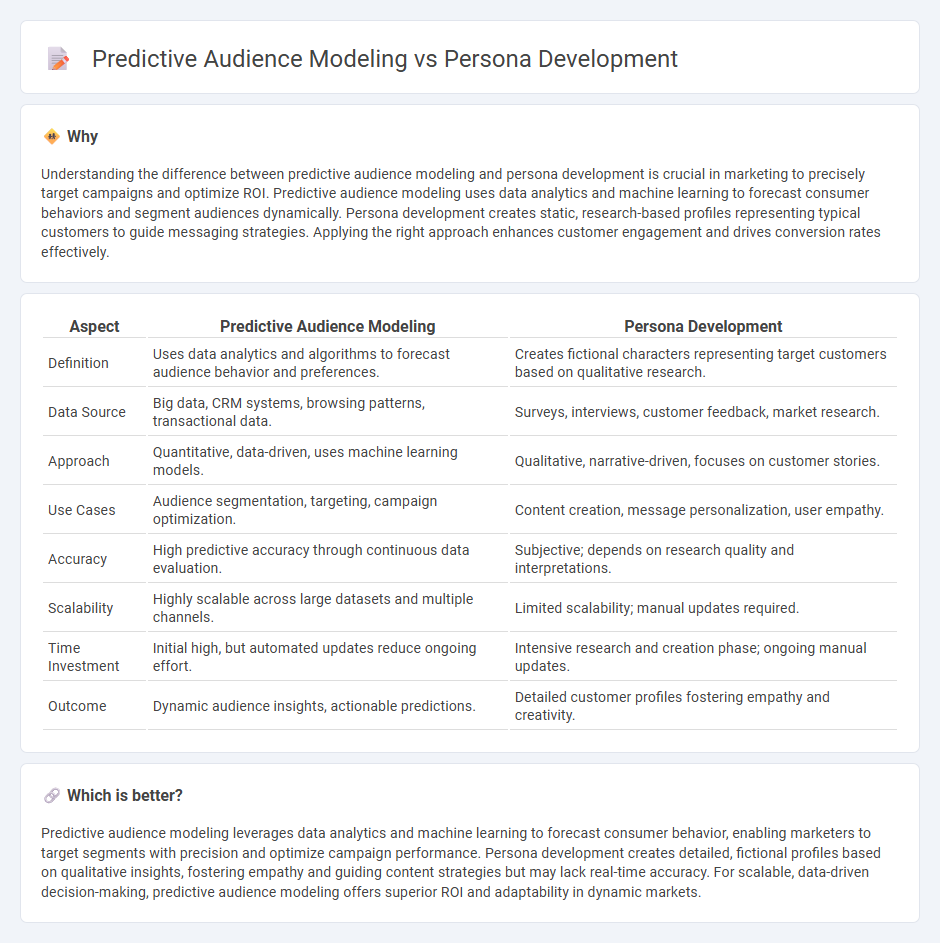
Predictive audience modeling uses data-driven algorithms to identify and target specific consumer segments based on behaviors and trends, offering precise and scalable marketing insights. In contrast, persona development relies on qualitative research to create detailed fictional profiles representing target customers, emphasizing empathy and human-centered design. Explore how integrating these approaches can enhance your marketing strategies and drive engagement.
Why it is important
Understanding the difference between predictive audience modeling and persona development is crucial in marketing to precisely target campaigns and optimize ROI. Predictive audience modeling uses data analytics and machine learning to forecast consumer behaviors and segment audiences dynamically. Persona development creates static, research-based profiles representing typical customers to guide messaging strategies. Applying the right approach enhances customer engagement and drives conversion rates effectively.
Comparison Table
| Aspect | Predictive Audience Modeling | Persona Development |
|---|---|---|
| Definition | Uses data analytics and algorithms to forecast audience behavior and preferences. | Creates fictional characters representing target customers based on qualitative research. |
| Data Source | Big data, CRM systems, browsing patterns, transactional data. | Surveys, interviews, customer feedback, market research. |
| Approach | Quantitative, data-driven, uses machine learning models. | Qualitative, narrative-driven, focuses on customer stories. |
| Use Cases | Audience segmentation, targeting, campaign optimization. | Content creation, message personalization, user empathy. |
| Accuracy | High predictive accuracy through continuous data evaluation. | Subjective; depends on research quality and interpretations. |
| Scalability | Highly scalable across large datasets and multiple channels. | Limited scalability; manual updates required. |
| Time Investment | Initial high, but automated updates reduce ongoing effort. | Intensive research and creation phase; ongoing manual updates. |
| Outcome | Dynamic audience insights, actionable predictions. | Detailed customer profiles fostering empathy and creativity. |
Which is better?
Predictive audience modeling leverages data analytics and machine learning to forecast consumer behavior, enabling marketers to target segments with precision and optimize campaign performance. Persona development creates detailed, fictional profiles based on qualitative insights, fostering empathy and guiding content strategies but may lack real-time accuracy. For scalable, data-driven decision-making, predictive audience modeling offers superior ROI and adaptability in dynamic markets.
Connection
Predictive audience modeling leverages data analytics to identify patterns in consumer behavior, enabling marketers to create accurate and dynamic customer personas. These personas represent segmented target audiences with detailed attributes and preferences, enhancing campaign personalization. By integrating predictive insights, persona development becomes more precise, improving audience targeting and driving higher engagement rates.
Key Terms
Persona Development:
Persona development crafts detailed fictional characters based on demographic, psychographic, and behavioral data to represent target customer segments for marketing strategies. This method emphasizes understanding motivations, goals, and pain points, enabling tailored content and product offerings that resonate deeply with audience needs. Explore more to harness Persona Development for precise audience engagement and improved ROI.
Demographics
Persona development centers on creating detailed profiles based on demographic data such as age, gender, income, and education to humanize target customers and tailor marketing strategies accordingly. Predictive audience modeling employs statistical algorithms and machine learning techniques to analyze demographic trends and forecast future behaviors within specific segments. Explore how integrating these approaches can enhance precision in targeting and customer engagement.
Psychographics
Persona development leverages detailed psychographic profiles, such as values, motivations, and lifestyle traits, to create fictional representations of target users. Predictive audience modeling applies advanced machine learning algorithms to analyze psychographic data patterns and forecast behaviors across large segments. Explore the nuanced differences between these approaches to enhance targeting strategies.
Source and External Links
How to Run a Persona Workshop - A guide to organizing collaborative sessions for developing and refining user personas through group discussions and empathy mapping exercises.
How To Create a Persona in Five Steps - A step-by-step guide on creating personas to better understand target audiences and design more effective products.
10 Steps to Creating a Persona - A comprehensive tutorial outlining the process of creating personas, including research, segmentation, and defining goals.
 dowidth.com
dowidth.com